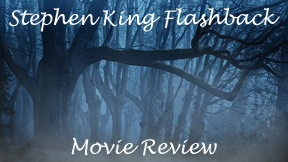“The Shining” (1980) is in a class of movies with “2001” and “Blade Runner” where they’re the most boring thing ever when you’re a kid. But as an adult, you realize why they are classics. Stanley Kubrick’s adaptation – loved by everyone except Stephen King, author of the 1977 novel – is an oddly economical 2-hour-plus piece of purist, parodic arthouse horror.
Gleefully macabre
I’ve heard the film described as the scariest ever, but viewers bring a lot of their own current mental state to horror. I personally find “The Shining” to be highly amusing (the hotel is built on an Indian burial ground – lol), with a gleefully macabre tone that undercuts themes such as hopelessness and career stress.
This is partly because of the over-the-top yet great performances from Jack Nicholson and Shelley Duvall. And perhaps it’s partly because “The Shining” is scary to me on some level, and my fear morphs into a state of giddy craziness, similar to Jack Torrance’s arc.

“The Shining” (1980)
Director: Stanley Kubrick
Writers: Stanley Kubrick, Diane Johnson (screenplay); Stephen King (novel)
Stars: Jack Nicholson, Shelley Duvall, Danny Lloyd
Fascinating location
But we begin with Kubrick’s master class in artful stage-setting. We see beautiful mountain-road scenery and dense, dark classical music tells us this nonetheless isn’t going to be a relaxing travelogue.
Throwaway lines establish that the Overlook Hotel, in the mountains of Colorado, might as well be as remote as outer space:
Jack: “I made the trip in three and a half hours.”
Hotel manager: “Well, that’s very good time, very good.”
And that’s in the summer, before the roads are snowed in. Later, we see how restless young Danny (Danny Lloyd) is in the car when the family drives to the Overlook to settle in for five winter months. When the phone lines go down, it’s considered a normal annual occurrence. So wife Wendy puts the more primitive radio to use.
Remoteness aside, the Overlook Hotel itself is so compelling it almost doesn’t need the additional wrinkle of a winter caretaker who slaughtered his family with an ax a decade before Jack gets the gig.
It’s like a haunted-location documentary as Danny rides around in a big circle through the corridors on his Big Wheel. This place is not merely huge to a kid, but to anyone, as Kubrick makes clear with his wide-angle shots. Hilariously, novelist Jack’s “office” – where he pounds away at his typewriter — is a massive, echoing reception room.
I theorize that any place that’s not regularly lived in is scary. A basement is scary, but so is an attic. A small space is scary, but so is the Overlook Hotel – especially when it’s empty. Or rather, “empty.”

A terrified Torrance
“The Shining” could be as cold as the snowscape outside, except for the very human performance from Duvall as Wendy, who I feel great sympathy for. She’s trapped with her husband and son, who are crazy in different ways. It’s enough to drive her a little crazy too. When Wendy runs in fear, waving a knife, it’s like her limbs barely cooperate. Her words often come out in a tremble.
Nicholson’s performance is flat-out delicious. A common criticism is that Jack makes the turn to crazy too early. Indeed, it’s surprising when he drops F-bombs on Wendy when she interrupts his writing work. But he’s an utter blast to watch.
Young Lloyd is asked to do a lot, including making the creaky voice of imaginary friend Tony by himself. This is another instance where Kubrick might be going for genre parody (“The Exorcist,” featuring two entities sharing one kid body, came out seven years before this).
Or maybe I admire the overall product enough that I make excuses for the sillier parts.
Is Kubrick winking at us?
Also suggesting Kubrick is winking at us: It’s amazing how quickly the elevator full of blood and the creepy twin girls appear to Danny (who has the titular ability to see horrific, if sometimes metaphorical, truths). Surely it would be more suspenseful if these images came later?
Well, maybe not, because the biggest bit of creepiness comes later when Jack finally enters the mysterious Room 237. The cook, Mr. Hallorann (Scatman Crothers), had warned Danny to not enter that room, which immediately makes it Chekov’s Room 237: Someone’s gonna go in there before the movie is over.
The beautiful nude woman turns into a hideous living corpse, terrifying Jack and making us feel some sympathy for him.
“The Shining’s” hinted backstories perhaps inspired “Bad Times at the El Royale,” built around the idea that any hotel will rack up tons of weird happenings – from suicides to sexual perversity — over the course of time.
Archetypal fears
On a grounded level, “The Shining” balances old-school fears of each of the three leads: the man’s pressure to be a breadwinner, the woman’s fear that her husband is unstable, and the kid’s basic need to have loving parents. We also see some of the child’s incredible adaptability, as Danny either invents or accepts an invisible friend to deal with his loneliness.
But any film can be closely analyzed and deemed to be substantial. That doesn’t make it not boring. We’re getting into matters of taste now, but I found many long scenes to be weirdly compelling.
Consider Jack talking to the ghost of the former caretaker, Grady (Philip Stone), in the restroom. Both stand frozen in place as the chat devolves from friendly into something bizarre and serious. Grady essentially instructs Jack to kill Wendy and Danny – something Jack is game for by this point.
Just as Kubrick was beyond crafting a carefully calibrated descent for Jack Torrance, on this viewing I didn’t feel the need to see that. I didn’t even think about it, because Nicholson wins me over every time he’s on screen.
I do want something more out of “The Shining” — not from the film itself but from the world around it. I’m looking forward to watching the 2019 sequel “Doctor Sleep,” and in general learning more about the film.
IMDb Top 250 trivia
- “The Shining” ranks No. 64 among IMDb’s Top 250 movies with an 8.4 rating.
- It’s No. 2 among Kubrick films, trailing “Paths of Glory” (No. 59, 8.4).
- It’s No. 3 among King adaptations, following “The Shawshank Redemption” (No. 1, 9.2) and “The Green Mile” (No. 29, 8.5).
On Fridays, RFMC reviews a Stephen King book, adaptation or related work. Click here to visit our Stephen King Zone.

